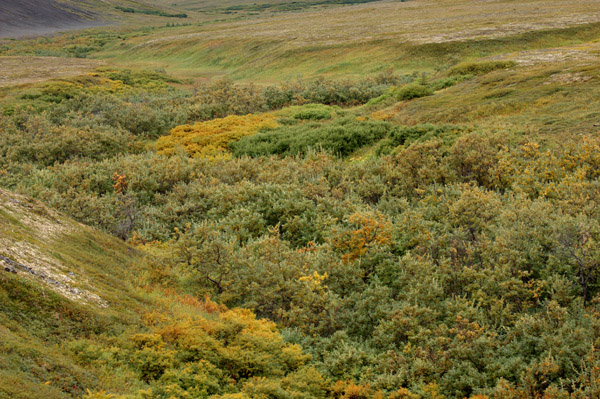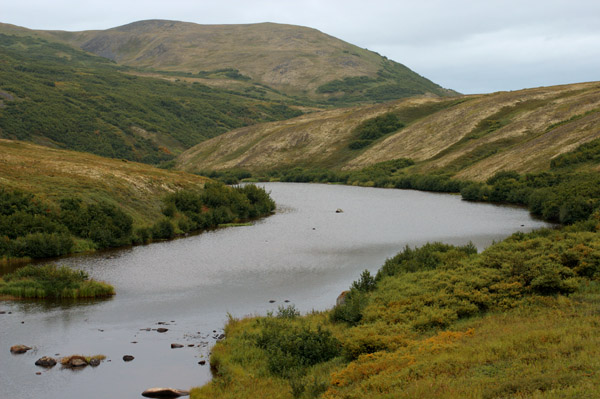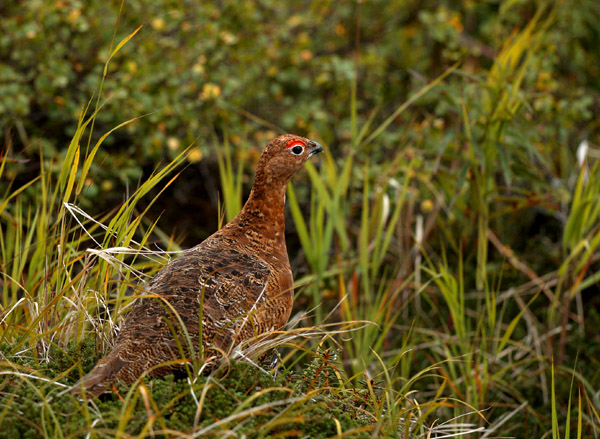|
The wind streams across the flats and scours the hilltops, punishing anything that sticks up too high. On the flats, the plants hug the ground in a close-knit mat, surviving by being low and crowded. The gullies provide larger windbreaks, so tall grass and bushes grow lush and green in their depths. From above this provides a nice aesthetic contrast with the stark tundra, but even before I descended I knew that the gullies would be difficult for walking.
I followed the Koktuli River on the tundra as long as I could. But eventually, crossing the gully was unavoidable. With each step downhill, the air stilled.
|

Smooth tundra flanks line a gully bristling with willow and alder.
|

Frying Pan Lake narrows at the southern end, and feeds into the Koktuli River.
|
As I descended, my three-inch tundra morphed quickly into three-foot grass and pushki (cow parsnip). A little further along, I dropped out of the open air altogether, and found myself thrashing through the thick willow brush, cursing my tangled feet, and then unexpectedly plunging a foot into a hidden, knee-deep stream. Realizing that I could see only a couple feet in front of me, I started talking to myself, as a warning to any bears that might be nearby. But my speech wasn't even half as loud as my thrashing progress. And any sensible bear would be up on the tundra with the blueberries, not down in the willow. I fell silent, saving my breath for the grind up through the thicket on the far side of the gully.
|
|
In the afternoon, the wind slacked off. With the rain now only a slight mist, and the wind gone, it was quiet on the grey tundra. For a minute, all I could hear was the wet ground squelching underfoot. Then a soft buzzing appeared. The buzzing quickly grew stronger, and the tiny insects responsible for it started bouncing off my face chaotically, forming a persistent cloud around my head. I waved my hands furiously in front of my face as I walked, talking to the insects, and looking, I'm sure, like a complete nutcase. A white helicopter roared overhead nearby, temporarily drowning out the buzz, but failing to frighten the insects. The wind of only a few hours earlier now seemed like an incredible luxury.
|
 A rock ptarmigan ran ahead of me along the tundra, trying to blend in.
A rock ptarmigan ran ahead of me along the tundra, trying to blend in.
|
|
By evening, the wind returned, and I set up my tarp in the lee of a waist-high boulder. I bent my mind back to the strange reason I had come to this wilderness. I'd just spent the whole day hiking in what could become a giant tailings lake. I didn't start at the beginning, and I didn't reach the end. I could have walked miles further downstream, and still been underneath that tailings lake footprint. How could everything around me - literally everything I could see, and everything I walked through all day, disappear into a toxic muck pond? Standing alone in the middle of it, I found it hard to believe.
When I woke the next morning, the inside of my tarp was covered in mosquitoes. The weather outside was calm, but if anything, even more gray and un-photogenic than the day before. I was starting to get frustrated. I'd had gorgeous weather on my way out to the mine site. In the sun, the rounded hills had looked soft and inviting. Shallow glacial lakes had sparkled and shone in the dips between them, reflecting the puffy white clouds in their blue surfaces. This place was beautiful, just not when I was sitting, ready with my camera.
Trapped under a grey sky, I wondered how I could possibly show people that the tundra was worth saving. Would people see my grey pictures and think, "Good riddance."?
I was circling back northeast, towards the ore deposit, and the bulk of the exploration activity. The thick tundra sagged and shifted disconcertingly under my feet as I crossed the valley floor near Frying Pan Lake, sometimes plunging me ankle-deep in mud. I quickly headed uphill, to a series of low ridges and small ponds, skirting the valley floor.
|

The reflections on Frying Pan Lake shine in a rare flash of sun.
|
|
The hillside I was traversing was part of a taller ridge, and protected from some of the wind. It was a confusing maze of tundra meadows and thick brush, and I backtracked several times as I searched for caribou trails that would carry me around the thickets. But most of the brushy gullies were unavoidable, and I thrashed my way through them reluctantly, filling my hair with willow leaves. Ground squirrel holes dotted the dry ground, and beavers dammed many of the ponds. Off to my left, the helicopter roar was nearly constant over the valley floor, though the brushy ridges often blocked them from view.
|
|